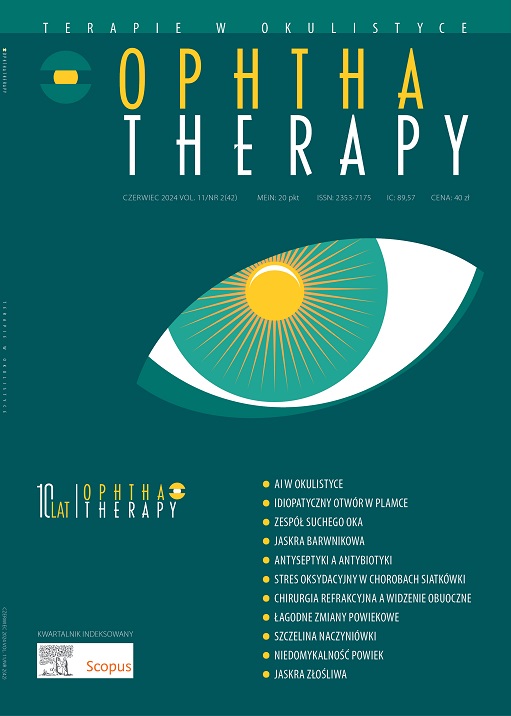Efficient antiseptic prophylaxis in the era of antibiotic resistance Review article
Main Article Content
Abstract
An excessive use of antibiotic preparations in daily practice frequently without clear medical indications has led to the development of dangerous strains of bacteria resistant to the available pharmaceutical drug. Today, antibiotics are used not only to treat infections, but also as preoperative infection prevention. Intravitreal injection is one of the most commonly performed ophthalmological procedures where, until recently, perioperative antibiotics prevention was recommended. Currently, antibiotics in this procedure are not advised at all. Nowadays, for anti-infective prophylaxis we use iodopovidone and preparations that combine antiseptic and soothing effects.
Downloads
Article Details

This work is licensed under a Creative Commons Attribution-NonCommercial-NoDerivatives 4.0 International License.
Copyright: © Medical Education sp. z o.o. License allowing third parties to copy and redistribute the material in any medium or format and to remix, transform, and build upon the material, provided the original work is properly cited and states its license.
Address reprint requests to: Medical Education, Marcin Kuźma (marcin.kuzma@mededu.pl)
References
2. Ciulla TA, Starr MB, Masket S. Bacterial endophthalmitis prophylaxis for cataract surgery: an evidence-based update. Ophthalmology. 2002; 109: 13-24.
3. Pinna A, Usai D, Sechi LA et al. Detection of virulence factors in Pseudomonas aeruginosa strains isolated from contact lens-associated corneal ulcers. Cornea. 2008; 27: 320-6.
4. Sengupta J, Khetan A, Saha S et al. Candida keratitis: emerging problem in India. Cornea. 2012; 31: 371-5.
5. Kreslov MS, Castellarin AA, Zarbin MA. Endophthalmitis. Surv Ophthalmol. 1998; 43: 193-224.
6. American Academy of Ophthalmology. Bacterial keratitis preferred practice patterns.
7. Leaming DV. American Society of Cataract and Refractive Surgery: practice styles and preferences of ASCRS members: 2000 survey. J Cataract Refract Surg. 2001; 27: 948-955.
8. Kim SJ, Toma HS. Antimicrobial resistance and ophthalmic antibiotics: 1-year results of a longitudinal controlled study of patients undergoing intravitreal injections. Arch Ophthalmol. 2011; 129: 1180-8.
9. Yin VT, Weisbrod DJ, Eng KT et al. Antibiotic resistance of ocular surface flora with repeated use of a topical antibiotic after intravitreal injection. JAMA Ophthalmol. 2013; 131: 456-61.
10. Phan ADT. Intravitreal Injection Procedure.
11. Uhr JH, Xu D, Rahimy E et al. Current Practice Preferences and Safety Protocols for Intravitreal Injection of Anti-Vascular Endothelial Growth Factor Agents. Ophthalmol Retina. 2019; 3(8): 649-55. https://doi.org/10.1016/j.oret.2019.03.013.
12. 2018 Update on Intravitreal Injections: Euretina Expert Consensus Recommendations.
13. van Ketel WG. Allergic contact eczema by Hexomedine. Contact Dermatitis. 1975; 1(5): 332.
14. Granel F, Lozniewski A, Barbaud A et al. Cutaneous infection caused by Tsukamurella paurometabolum. Clin Inf Dis. 1996; 23(4): 839-40.
15. Grare M, Dibama HM, Lafosse S et al. Cationic compounds with activity against multidrug-resistant bacteria: interest of a new compound compared with two older antiseptics, hexamidine and chlorhexidine. Clin Microbiol Inf. 2010; 16(5): 432-8.
16. Pinna A, Donadu MG, Usai D et al. In Vitro Antimicrobial Activity of a New Ophthalmic Solution Containing Hexamidine Diisethionate 0.05% (Keratosept). Cornea. 2020; 39(11): 1415-8. https://doi.org/10.1097/ICO.0000000000002375.
17. Pinna A, Donadu MG, Usai D et al. In vitro antimicrobial activity of a new ophthalmic solution containing povidone-iodine 0.6% (IODIM). Acta Ophthalmol. 2020; 98: e178-80.
18. Mencucci R, Favuzza E, Bottino P et al. A new ophthalmic formulation containing antiseptics and dexpanthenol: In vitro antimicrobial activity and effects on corneal and conjunctival epithelial cells. Exp Eye Res. 2020; 201: 108269. https://doi.org/10.1016/j.exer.2020.108269.
19. Hunyor AP, Merani R, Darbar A et al. Topical antibiotics and intravitreal injections. Acta Ophthalmol. 2018; 96: 435-41.
20. Grzybowski A, Told R, Sacu S et al.; Euretina Board. 2018 Update on Intravitreal Injections: Euretina Expert Consensus Recommendations. Ophthalmologica. 2018; 239(4): 181-93. https://doi.org/10.1159/000486145.
21. Avogaro F, Florido A, Calandri A et al. Intravitreal injections primary prevention: a case-control study. Eur Rev Med Pharmacol Sci. 2023; 27(8): 3664-9. https://doi.org/10.26355/eurrev_202304_32153.

